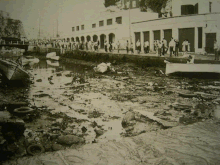Meteotsunami
A meteotsunami or meteorological tsunami is a tsunami- like phenomenon that is caused by air pressure fluctuations and resonance phenomena or strong winds e.g. B. can be triggered on a storm front.
It is known by different names in different countries: Rissaga in the Balearic Islands , Milghuba in Malta , Marrubio in Sicily , Stigazzi in the Bay of Fiume and Abiki or Yota in Japan . In the North and Baltic Seas (such as in Finland ) it has also been described under the name fur seal .
fur seal
The German term Seebär for a Meteotsunami originated from a corruption of the Low German word boeren (cf. in English : bore ), which roughly means "to lift". As early as 1756, the German natural scientist Daniel Gottlob Thebesius described a meteotsunami under the name sea bear. Fur seals occur on both the North and Baltic Sea coasts. Fur seals are documented for the North Frisian island of Sylt for June 14, 1964 and June 18, 2002, among others. However, it is believed that the number of meteotsunamis that actually occurred is higher.
Fur seals with a wave height of over one meter are extremely rare. The danger of fur seals, however, is that they (unlike storm surges ) cannot be predicted.
Rissaga
Rissaga (Resarca, Rissague) is a hydrological phenomenon that occurs in the port of Ciutadella on the Balearic island of Menorca . It only occurs once or twice a year and is usually weak. In individual cases, however, the harbor basin runs almost completely empty within a few seconds, the water then returns in a huge wave and sometimes causes great damage, as on June 21, 1984 and June 15, 2006.
According to studies by the University of the Balearic Islands, these water level fluctuations arise neither from seismic causes nor from the tides , because they correlate with a sudden short drop in air pressure of max. 8 hPa , preceded by numerous air pressure fluctuations of 2 hPa every minute.
The pressure oscillations of the atmosphere naturally affect the body of water and trigger oscillations here, which cause a wandering wave. Two prerequisites are required for large fluctuations in water level to occur on the shore: shallow water depth and a narrow bay. At a measuring point in front of the Ciudadelas harbor bay, the water level fluctuates by max. 60 centimeters, inside the bay by well over two meters.
Particularly high tidal waves with a height of up to 4 m and thus resembling a tsunami were observed when special meteorological factors occurred. Typically it is humid, the sky is overcast and there is a south wind. Since the beginning of the measurements, the Rissaga has only occurred once with a north wind.
Last major occurrences of this effect:
- June 21, 1984: millions of euros in damage to bars, restaurants and boats
- June 15, 2006: Increase of four meters within a very short time, numerous boats destroyed, bars and restaurants flooded
- July 16, 2018: The north of Mallorca and the neighboring island of Menorca were hit by two mini tsunamis. This resulted in floods, especially in the ports of Port d'Antratx and Port d'Alcúdia.
causes
Blocking air currents create local differences in air pressure that must hit ocean waves at the same speed. Then there can be a resonance between air pressure and water waves, so that waves with a height of up to several decimeters can arise due to excessive resonance. When the waves reach a bay, they are dammed up like with conventional tsunamis and reach heights of several meters, provided that the bay has the "correct" length so as not to wipe out the waves but to reinforce them.
Further occurrences
- June 27, 2011: An approximately one meter high tsunami washed over the coasts of south-west England and flooded bays.
- June 13, 2013: A mysterious tsunami over a thousand kilometers wide flooded beaches on the east coast of the United States.
| place | country | Max. Height (m) |
|---|---|---|
| Nagasaki Bay | Japan | 4.8 |
| Pohang Harbor | South Korea | 0.8 |
| Longkou Harbor | People's Republic of China | 3 |
| Ciutadella port | Spain | 4th |
| Gulf of Trieste | Italy | 1.5 |
| Western part of Sicily | Italy | 1.5 |
| Malta | Malta | 1 |
| Stari degree | Croatia | 2.5 |
| Mali Lošinj | Croatia | 0.8 |
literature
- Dieter Etling: Tsunami and Meteotsunami (PDF; 10.74 MB). In: Communications DMG 1/2015, pp. 2–6.
- Ivica Vilibić, et al .: Meteorological Tsunamis: the US East Coast and other coastal regions. Springer, Cham 2015, ISBN 978-3-319-12711-8 .
Web links
- deutschlandfunk.de , Forschungs aktuell , February 15, 2018, Dagmar Röhrlich : When the storm drives the wave
- Article University of the Balearic Islands , imedea.uib.es (Spanish) - February 5, 2020 no longer available
- Almanac with pictures mycl.lu, 2006 (PDF file; 115 kB)
See also
- Vela Luka # Other
- Mali Lošinj: Poplava 2008 on YouTube , accessed on November 13, 2018.
Individual evidence
- ↑ Meteo-Tsunamis - When the storm drives the wave . In: Deutschlandfunk . ( deutschlandfunk.de [accessed on March 11, 2018]).
- ↑ Note 1 hPa (hectopascal) corresponds to 1 mbar or around 1 cm water column .
- ↑ Mini tsunami on Mallorca: two bays completely flooded
- ↑ Axel Bojanowski : Surprising flood: Hiccups over the Mediterranean cause tsunamis. In: Spiegel Online . December 28, 2006, accessed January 6, 2017 .
- ↑ Axel Bojanowski: Rare natural event: air vortex washes tsunami on England's coast. In: Spiegel Online . July 8, 2011, accessed January 6, 2017 .
- ↑ Axel Bojanowski: Tsunami out of nowhere: Mysterious 1000-kilometer wave hits the US east coast. In: Spiegel Online . July 2, 2013, accessed January 6, 2017 .
